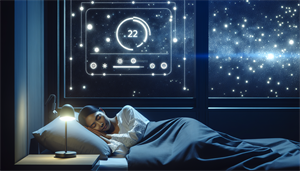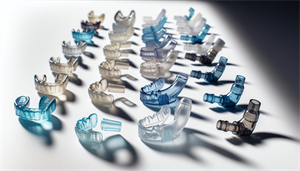Have you ever wondered about the enigmatic world of dreams and how they intertwine with our waking lives? Now, imagine the added complexity when sleep disorders enter the equation.
The connection between sleep apnea and dreams is a fascinating one, drawing us into a nocturnal narrative that can offer profound insights into our subconscious minds. Do you dream with sleep apnea? Understanding this connection can provide valuable information about your sleep health.
Key Takeaways
-
Sleep apnea, particularly during REM sleep, can lead to fewer dream recollections, altered dream content, and distressing sleep apnea-related nightmares such as choking or suffocation.
-
CPAP therapy for sleep apnea significantly improves sleep stages, allowing for more normal and less distressing dreams, highlighting the dual benefit of treating both physical symptoms and enhancing sleep quality.
-
Addressing psychological factors like anxiety and depression is essential for managing sleep apnea’s impact on dreams, as they can exacerbate the frequency and intensity of nightmares associated with the condition.
Unraveling the Mystery: Do Sleep Apnea Patients Dream?
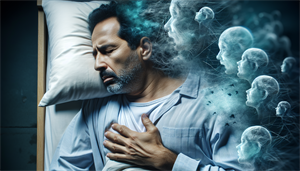
Sleep apnea, a sleep disorder typified by repetitive episodes of paused or shallow breathing, has profound implications on an individual’s health and wellness. However, does this disorder extend its influence into our dreams, the captivating and often perplexing narratives that transpire during our sleep? The answer is a resounding yes. Sleep apnea can significantly impact the ability of patients to recall their dreams. The reason lies in the realm of REM (rapid eye movement) sleep, the stage when most dreams occur.
The interference of REM sleep by sleep apnea can hinder the attainment of deep sleep, the stage where vibrant dreams predominantly transpire. As a result, sleep apnea patients often experience fewer dreams and have difficulty remembering them. But it’s not just the quantity of dreams that is affected - the quality and content of dreams can also be significantly altered. Sleep apnea nightmares can occur, causing distress to the individual.
However, the effect of sleep apnea on dreams is not uniform across all patients. Some individuals may have fewer dreams, while others may experience intense or disturbing dreams. The key takeaway? If you or a loved one have sleep apnea, your dreams may hold clues to your condition and its severity.
The Impact of Obstructive Sleep Apnea on Dream Frequency and Vividness
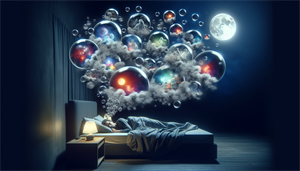
Obstructive sleep apnea, a variant of sleep apnea marked by a blocked airway, can notably disrupt sleep cycles. This can lead to sleep deprivation, reduced frequency and vividness of dreams, and potential nightmares associated with breathing difficulties.
Research findings on dreams in patients with obstructive sleep apnea are contradictory. Some studies have reported fewer dreams in OSA patients, while others have observed an increase in dreams with emotional content, particularly those with violent and hostile themes. In severe cases, patients may experience vivid and disturbing dreams that can turn into nightmares, often involving negative emotions or sensations like choking, which can disrupt REM sleep.
Considering the intricate relationship between obstructive sleep apnea and dreams, future studies are required to deepen our understanding of this link. It is recommended that future studies:
-
Differentiate between REM-predominant OSA and non-stage specific OSA
-
Use functional brain imaging
-
Consider the impact of sleep apnea treatment options, such as CPAP therapy, on dreams.
Nighttime Narratives: Understanding Sleep Apnea Related Nightmares
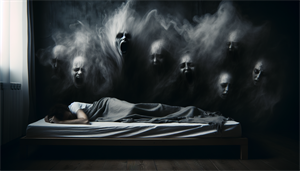
A particularly noteworthy aspect of sleep apnea dreams is the common occurrence of nightmares. Sleep apnea-related nightmares often feature sensations of suffocation, choking, or drowning. Patients often describe dreams involving:
-
strangulation
-
choking
-
attempting to breathe underwater
-
attempting to breathe in space
In essence, these vivid nightmares mirror the respiratory challenges faced by individuals with sleep apnea during sleep.
The distressing nightmares that severe sleep apnea patients experience can worsen daytime anxiety and depression. The fear and panic associated with dreams of suffocation and drowning, as well as the physical sensation of gasping for air upon waking, can heighten stress levels and raise the likelihood of mood disorders.
Intervening in the sleep disorder can aid in easing these troubling dreams. With appropriate treatment, sleep apnea patients can experience a reduction in nightmares, leading to more restful sleep and improved daytime functioning. This highlights the importance of timely diagnosis and effective treatment for sleep apnea.
The Paradox of Dream Recall in Sleep Apnea Sufferers
The association between sleep apnea and dream recall is intricate and somewhat contradictory. Some studies indicate decreased recall among sleep apnea patients, while others indicate heightened recall of aggressive or emotionally charged dreams. This paradox can be partly explained by the disruption of the sleep cycle, particularly REM sleep, in sleep apnea patients.
Interestingly, there seems to be a correlation between OSA patients and increased dream recall frequency, particularly with emotional content such as aggressive and violent themes. This could be due to the disruption of REM sleep in these patients. However, dream recall varies among individuals with the disorder, with some able to recall their dreams while others are not.
Research in this area is ongoing, and findings are varied. Some studies highlight decreased dream recall, while others emphasize heightened recall of emotionally charged dreams. This underlines the need for further research to fully understand the complex relationship between sleep apnea and dream recall.
Breathing Easy: How CPAP Therapy Transforms Sleep and Dreams

Continuous Positive Airway Pressure (CPAP) therapy is a prevalent treatment for sleep apnea. Using a CPAP machine, the therapy delivers pressurized air through a mask and tubing, keeping the airway open during sleep and preventing interruptions in breathing. But can this therapy also transform the landscape of dreams for sleep apnea patients?
Indeed, CPAP therapy allows individuals with sleep apnea to reach profound sleep stages, thereby enhancing the probability of more regular dreaming. Furthermore, it alters dream content, leading to a decrease in nightmares and a reduction in unpleasant dream themes.
In essence, CPAP therapy not only treats the physical symptoms of sleep apnea but also enhances the overall sleep experience. By improving breathing during sleep, it results in more restful sleep and reduces the occurrence of nightmares, leading to a calmer and better dream experience for sleep apnea patients.
The Link Between Sleep Disorders and Night Terrors
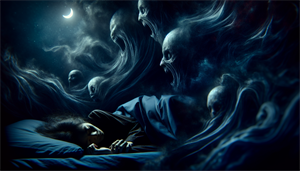
Although nightmares are a frequent aspect of sleep apnea, another, more severe phenomenon that can transpire is night terrors. Experiencing sleep apnea and nightmares can be distressing for individuals, but night terrors are episodes of intense fear and anxiety that occur during sleep, often causing the affected individual to wake up frightened. Unlike nightmares, which are disturbing dreams, night terrors involve partial awakening from sleep with possible physical reactions such as thrashing or screaming.
Sleep disorders such as sleep apnea can heighten the risk of experiencing parasomnias, like night terrors. Individuals with sleep disorders may experience night terror episodes characterized by screaming, intense fear, and flailing while still being asleep. These episodes are more commonly observed in young children, but can also occur in adults.
Understanding the link between sleep disorders and night terrors can help individuals and healthcare professionals devise effective treatment strategies. As with nightmares, addressing the underlying sleep disorder can help reduce the occurrence of night terrors.
Psychological Perspectives: Anxiety, Depression, and Their Role in Sleep Apnea Dreams
Psychological elements can notably impact the dream experiences of individuals with sleep apnea. Anxiety and depression, in particular, can play a substantial role in the frequency and intensity of sleep apnea-related dreams. The stress induced by apneic events during sleep can generally influence the emotional content of dreams, leading to more frequent and distressing nightmares for individuals with both sleep apnea and higher anxiety levels.
Depression, including daytime depression, can heighten the chances of experiencing nightmares. This condition frequently coexists with anxiety and can intensify the discomfort caused by nightmares, especially in individuals with post-traumatic stress disorder who also have comorbid OSA.
The symptoms of anxiety and depression are frequently observed in sleep apnea patients, as the repeated cessation of breathing during sleep can take a toll on mental health. Therefore, addressing these psychological issues is a crucial aspect of managing sleep apnea and its impact on dreams.
Strategies for Improving Sleep Quality and Reducing Bad Dreams
Boosting sleep quality and reducing unpleasant dreams can significantly augment the general well-being of individuals suffering from sleep apnea. Here are some lifestyle changes that can contribute to improving sleep quality:
-
Weight loss
-
Increased physical activity
-
Smoking cessation
-
Adjusting sleep schedules
Stress reduction strategies, such as regular exercise, yoga, and meditation, can also help alleviate stress and anxiety, leading to improved sleep quality and potentially reducing the frequency of bad dreams. In addition, effective treatment options for sleep apnea patients can reduce the occurrence of bad dreams and include CPAP therapy, surgical interventions for specific jaw structure issues, and maintaining regular physical activities like yoga and meditation.
Ultimately, a comprehensive approach that addresses both lifestyle factors and medical treatments is the most effective way to improve sleep quality and reduce bad dreams in individuals with sleep apnea.
Decoding Dreams: What Your Sleep Apnea Dreams May Be Telling You
The dreams of individuals battling sleep apnea can offer considerable emotional content and insights into their subconscious psyche. By analyzing these dreams, we can gain a better understanding of the individual’s emotional state and experiences related to their sleep disorder.
Common themes in sleep apnea dreams often include difficulty breathing, drowning, or being out of breath. These dreams can mirror the respiratory challenges faced by individuals with sleep apnea during sleep. Fragmented dream formation and disturbing content can be attributed to disrupted sleep mechanisms, which can impact the development and recall of dreams.
In essence, sleep apnea dreams can provide a unique window into the emotional and psychological experiences of individuals with this sleep disorder. By understanding and addressing these dreams, individuals and healthcare professionals can improve treatment strategies and enhance the overall well-being of sleep apnea patients.
Navigating Diagnosis and Treatment: From Sleep Study to CPAP Machine
The diagnosis of sleep apnea encompasses a thorough process that involves symptom screening, carrying out sleep studies, and consulting with healthcare experts. The two primary methods for diagnosing sleep apnea are polysomnography, an in-lab sleep study that requires an overnight stay, and at-home sleep studies. Polysomnography is considered more accurate in diagnosing sleep apnea.
Polysomnography, also known as a sleep study, is a thorough diagnostic examination that monitors different bodily functions during sleep. It is used to detect disturbances in sleep patterns and to diagnose the root cause of sleep disorders.
Following diagnosis, personalized treatment plans are developed. These may include lifestyle changes, medical treatments such as CPAP therapy, and potentially surgical interventions. By addressing the underlying sleep disorder, these treatments can improve sleep quality, reduce nightmares, and promote better overall sleep.
Summary
The world of sleep apnea and dreams is a fascinating one, filled with complexities, paradoxes, and profound insights. Sleep apnea can significantly affect dream patterns, leading to fewer dreams, difficulties in dream recall, and an increased likelihood of nightmares and night terrors. However, with effective treatments like CPAP therapy, individuals with sleep apnea can experience improved sleep quality, fewer nightmares, and better dream experiences.
Understanding the link between sleep apnea and dreams can provide valuable insights into the emotional and psychological experiences of individuals with this sleep disorder. By addressing these issues, we can not only improve the quality of sleep but also enhance the overall well-being of individuals with sleep apnea.
Frequently Asked Questions
Does sleep apnea make you dream a lot?
Yes, sleep apnea may lead to less frequent or shorter periods of dreaming, and the content of dreams can be affected, potentially becoming disturbing or leading to nightmares due to erratic sleep patterns.
What sleep disorder causes vivid dreams?
Narcolepsy frequently causes vivid, bizarre dreams. It is a common symptom of the disorder.
Can sleep apnea cause dream enactment?
Yes, sleep apnea can cause dream-enactment behaviors, especially during arousals from NREM and REM sleep due to fragmented sleep. It is termed pseudo RBD.
Symptoms of sleep apnea?
The symptoms of sleep apnea include: obstructive sleep apnea symptoms.
How does CPAP therapy affect dreams?
CPAP therapy can increase dream frequency and alter dream content, leading to a decrease in nightmares and a reduction in unpleasant dream themes. This can result in a more restful sleep experience.
